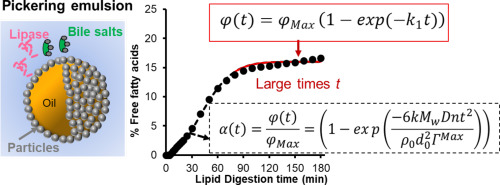Advances in Colloid and Interface Science ( IF 15.9 ) Pub Date : 2018-10-22 , DOI: 10.1016/j.cis.2018.10.002 Anwesha Sarkar , Shuning Zhang , Melvin Holmes , Rammile Ettelaie

|
Lipid digestion is a bio-interfacial process that is largely governed by the binding of the lipase-colipase-biosurfactant (bile salts) complex onto the surface of emulsified lipid droplets. Therefore, engineering oil-water interfaces that prevent competitive displacement by bile salts and/or delay the transportation of lipase to the lipidoidal substrate can be an effective strategy to modulate lipolysis in human physiology. In this review, we present the mechanistic role of Pickering emulsions i.e. emulsions stabilised by micron-to-nano sized particles in modulating the important fundamental biological process of lipid digestion by virtue of their distinctive stability against coalescence and resilience to desorption by intestinal biosurfactants. We provide a systematic summary of recent experimental investigations and mathematical models that have blossomed in the last decade in this domain. A strategic examination of the behavior and mechanism of lipid digestion of droplets stabilised by particles in simulated biophysical environments (oral, gastric, intestinal regimes) was conducted. Various particle-laden interfaces were considered, where the particles were derived from synthetic or biological sources. This allowed us to categorize these particles into two classes based on their mechanistic role in modifying lipid digestion. These are ‘human enzyme-unresponsive particles’ (e.g. silica, cellulose, chitin, flavonoids) i.e. the ones that cannot to be digested by human enzymes, such as amylase, protease and ‘human enzyme-responsive particles’ (e.g. protein microgels, starch granules), which can be readily digested by humans. We focused on the role of particle shape (spherical, anisotropic) on modifying both interfacial and bulk phases during lipolysis. Also, the techniques currently used to alter the kinetics of lipid digestion using intelligent physical or chemical treatments to control interfacial particle spacing were critically reviewed. A comparison of how various mathematical models reported in literature predict free fatty acid release kinetics during lipid digestion highlighted the importance of the clear statement of the underlying assumptions. We provide details of the initial first order kinetic models to the more recent models, which account for the rate of adsorption of lipase at the droplet surface and include the crucial aspect of interfacial dynamics. We provide a unique decision tree on model selection, which is appropriate to minimize the difference between experimental data of free fatty acid generation and model predictions based on precise assumptions of droplet shrinkage, lipase-binding rate, and nature of lipase transport process to the particle-laden interface. Greater insights into the mechanisms of controlling lipolysis using particle-laden interfaces with appropriate mathematical model fitting permit better understanding of the key lipid digestion processes. Future outlook on interfacial design parameters, such as particle shape, size, polydispersity, charge, fusion, material chemistry, loading and development of new mathematical models that provide closed-loop equations from early to later stages of kinetics are proposed. Such future experiments and models hold promise for the tailoring of particle-laden interfaces for delaying lipid digestion and/or site-dependent controlled release of lipidic active molecules in composite soft matter systems, such as food, personal care, pharmaceutical, healthcare and biotechnological applications.
中文翻译:

皮克林乳液消化的胶体方面:脂质消化动力学的实验和理论模型
脂质消化是一种生物界面过程,很大程度上受脂肪酶-固溶酶-生物表面活性剂(胆盐)复合物结合到乳化脂质液滴表面上的约束。因此,防止胆汁盐竞争性置换和/或延迟脂肪酶向脂质样底物的运输的工程油-水界面可以是在人体生理学中调节脂解的有效策略。在这篇综述中,我们介绍了皮克林乳液的机械作用,即微米级至纳米级颗粒稳定的乳状液,由于其对凝聚的独特稳定性和肠内生物表面活性剂的解吸能力,在调节脂质消化的重要基础生物学过程中具有重要作用。我们提供了最近的实验研究和数学模型的系统总结,最近的研究和数学模型在此领域得到了发展。在模拟的生物物理环境(口腔,胃,肠)中,对颗粒稳定化的液滴的脂质消化的行为和机理进行了策略性检查。考虑了各种载有颗粒的界面,其中颗粒来自合成或生物来源。这使我们可以根据它们在修饰脂质消化中的机械作用将这些颗粒分为两类。这些都是 '人源酶无反应颗粒(例如二氧化硅,纤维素,甲壳质,类黄酮),即不能被人源酶(例如淀粉酶,蛋白酶和“人源酶促反应颗粒”)消化的颗粒(例如蛋白质微凝胶,淀粉颗粒),很容易被人消化。我们集中研究了颗粒形状(球形,各向异性)在脂解过程中修饰界面相和本体相的作用。同样,目前对使用智能物理或化学处理来控制界面颗粒间距来改变脂质消化动力学的技术进行了严格的综述。对文献报道的各种数学模型如何预测脂质消化过程中游离脂肪酸释放动力学的比较,突显了清晰阐明基本假设的重要性。我们向较新的模型提供了初始一阶动力学模型的详细信息,这些模型说明了脂酶在液滴表面的吸附速率,并包括界面动力学的关键方面。我们提供唯一决策树基于模型选择的模型,该模型可以最大程度地减少游离脂肪酸生成的实验数据与基于液滴收缩率,脂肪酶结合率以及脂肪酶向载有颗粒物的界面传输过程的性质的精确假设所得出的模型预测之间的差异。使用适当的数学模型拟合,通过使用带有粒子的界面控制脂解的机理的更深入的了解,可以更好地理解关键的脂质消化过程。提出了界面设计参数的未来展望,例如颗粒形状,尺寸,多分散性,电荷,聚变,材料化学,装载和开发新的数学模型,这些模型提供了动力学从早期到后期的闭环方程。









































 京公网安备 11010802027423号
京公网安备 11010802027423号